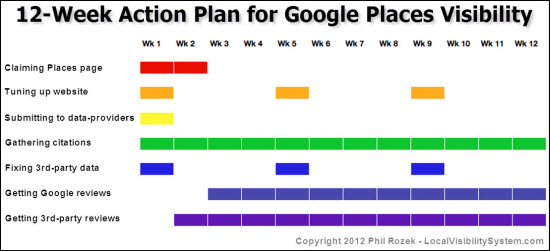 Unless you’re Arnold, furious bursts of action alone probably won’t get you very far. You need a plan for the action.
Unless you’re Arnold, furious bursts of action alone probably won’t get you very far. You need a plan for the action.
This is especially important if you’re trying to get your business visible in local search – and particularly important if you want to boost your visibility in the ever-finicky Google Places results.
That’s why I’ve sketched out a 12-week action plan you can follow to climb up a little higher on the local totem pole.
This is a timetable that’s worked really well for me and my clients, though I recognize there’s more than one way to skin a cat (figuratively speaking, of course…I like cats).
12 weeks may sound like a long time. But I’ve found that’s about how long it takes to implement everything you need to implement – especially if you have a business to run and have your hands full.
I always have a heck of a time trying to explain this verbally, but, as you can see, it’s actually pretty simple.
(Click below to see larger version of the timetable, or download it as a PDF)
Here’s a little more detail on each step:
![]() Claiming Places page
Claiming Places page
What you’re doing – First editing your Google Places page to make sure all the info is accurate, and then claiming your page so any edits you made actually stick. This is also when you should try to remove any duplicate Places listings for your business, and it’s when you should do any basic optimization, like picking your business categories.
Explanation of timing – It usually takes 7-12 days for Google to send you the postcard with the PIN that allows you to claim your Places page. Sometimes there are hang-ups, so it’s best to get started on this ASAP.
![]() Tuning up website
Tuning up website
What you’re doing – Making your site at least somewhat local-search-friendly. Optimize your title tag (with a light touch on the keywords), add a footer with your business name / address / phone number to each page of your site, and make sure your homepage (or whatever you use as your Google Places landing page) contains detail on the specific services you’re trying to get visible for. Also, make sure your site isn’t “over-optimized.”
Explanation of timing – What’s on your site has a huge influence on how you’ll rank in Google Places, especially in the ever-more-common “blended” local rankings. Therefore, if there’s even a chance you’re in trouble for keyword-spamminess, bad links, etc., you’ll want to start crawling out of the doghouse ASAP. Later on (like in weeks 5 & 9) is a good time to do some general housekeeping (like scanning for and fixing dead links), to see how you can beef up your pages with more service-relevant content, to put out a couple of blog posts, or maybe to do some link-building.
![]() Submitting to data-providers
Submitting to data-providers
What you’re doing – Listing your business on ExpressUpdateUSA and LocalEze, or – if you’re already listed there – making sure you’ve claimed those two listings. If possible, also claim your listing at MyBusinessListingManager and make sure it’s accurate. If you’ve got a few extra bucks, consider listing yourself on UBL.org.
Explanation of timing – It generally takes about 2 months for these data-providers to feed your business info to Google Places and to third-party sites (CitySearch, SuperPages, etc.). Because your rankings really depend on how consistent your business info is from site to site, it’s important to deal with these sites at the very beginning.
![]() Gathering citations
Gathering citations
What you’re doing – Getting listed on as may directory sites as you can. Start with the most important sites (like all the ones you see when you do a GetListed.org scan) and eventually try to get on some of the sites nobody’s heard of (like some of the sites on my Definitive Citations List). If possible, also try to list your business on (1) “hyperlocal” sites that are specific to your city/town and on (2) directory sites that are focused on your industry (i.e., your “vertical”). You can find these citation sources with the help of the Local Citation Finder, or by doing it the old-fashioned way.
Explanation of timing – You’ll be dealing with dozens of sites. Not only does it take time on your part to list yourself on them, but it also often takes weeks for these sites to list your business or process any edits you’ve made. You’ve got to start early. Plus, the more citations you can rack up over time, the better.
![]() Fixing 3rd-party data
Fixing 3rd-party data
What you’re doing – Checking the data-providers (see yellow) and at least some of your citation sources (see green) to make sure all your business info is 100% accurate – and fixing any inaccurate info you find. You should also check to make sure no duplicate Google Places listings have popped up – and remove any that have.
Explanation of timing – Making sure your citations don’t get FUBAR is an ongoing task, but there’s no need to check on them every day, because many of them take a while to update. Just check on them every few weeks (at least during the 12 weeks).
![]() Getting Google reviews
Getting Google reviews
What you’re doing – Asking customers to write reviews directly on your Google Places page. As you probably know, they’ll need Google / Gmail accounts to do this. I suggest you ask about half your customers to write Google reviews, and ask the other half to write reviews through 3rd-party review sites (see below).
Explanation of timing – If you haven’t claimed your Places page, or if your business has a bunch of duplicate Places pages floating around, it’s possible Google will erase your reviews. It’s best to hold off on requesting reviews until the Places pages aren’t being created, claimed, deleted, and otherwise jockeyed around. Plus, you’ll have your hands full anyway during the first couple of weeks.
![]() Getting 3rd-party reviews
Getting 3rd-party reviews
What you’re doing – Asking customers to write reviews on non-Google sites. CitySearch, InsiderPages, JudysBook, etc. (and Yelp, but Yelp has rules against requesting reviews). I’ve found that having reviews on a variety of sites helps your Places rankings, and of course it’s a great way to attract the users of those sites.
Explanation of timing – You can start asking for 3rd-party reviews even while your Places page is up in the air. But I suggest focusing on the other steps first – namely, having accurate and plentiful citations, a tuned-up website, and no duplicate Places pages. On the other hand, getting 3rd-party reviews is another ongoing task, which means it’s worth starting fairly early…hence why I say start around week 3.
You might be wondering a few things…
What if you’ve been wrangling with Google Places and local search in general for a while? I suggest you still follow the timeline. If one of the steps no longer applies to you – for example, if you’ve already submitted your info for the data-providers – then cross that one off and focus on the others.
What if you already have a bunch of citations or reviews? Keep racking ‘em up. Sure, don’t pour as much time into them as you would if you were starting at Square One. But don’t stop at “good enough” – especially if you’re in a competitive market.
What should you do after the 12 weeks? Given that you’ll likely be much more visible to local customers, it’ll largely be a matter of maintaining your visibility by continuing to work on all the steps (except red and yellow), but at a significantly slower pace. (For more, see my post on how to maintain your Places rankings.)
—
How does this action plan stack up with yours? Leave a comment!
